Infrastructure
Transforming India's Transport Infrastructure (2014- 2025)
Posted On: 11 JUN 2025 9:31AM
Key Takeaways
- PM GatiShakti unified planning across 44 ministries and 36 States/UTs on a GIS-based platform.
- National Highways grew by 60% (from 91,287 km to 1,46,204 km).
- Highway construction pace rose to 34 km/day (from 11.6 km/day in 2014).
- Bharatmala: 26,425 km awarded; 20,378 km constructed.
- 68 Vande Bharat trains running across 333 districts.
- Over 45,000 Rkm of rail electrification completed since 2014.
- Safety: Kavach deployed on key routes.
- 1,790 lifts and 1,602 escalators installed for accessibility.
- 7.8 lakh km rural roads completed (2014–2025).
- PMGSY-IV to connect 25,000 habitations by 2029.
- 88 airports operationalized under UDAN.
- Over 1.51 crore passengers flown under regional connectivity.
- Digi Yatra adopted in 24 airports; over 5.22 crore users.
- Drone policy & MRO reforms boosting local aviation ecosystem.
- Port capacity doubled to 2,762 MMTPA.
- Overall vessel turnaround time improved from 93 to 49 hours.
- Sagarmala completed 277 projects; Sagarmala 2.0 launched.
- Inland waterways cargo rose by 710% (from 18 MMT to 146 MMT).
- Green Hydrogen hubs under development at 3 major ports.
Introduction
Over the past decade, India has witnessed an unprecedented scale of infrastructure development, driven by a holistic and integrated approach. Anchored in key policy reforms and mission-mode projects, this transformation has not only expanded physical connectivity but also elevated economic productivity, reduced logistics costs, and enhanced service delivery. Major national initiatives like PRAGATI, PM GatiShakti, the National Logistics Policy, Bharatmala, Sagarmala, and UDAN have collectively shaped the vision of a connected and competitive India. From record expansions in highways and expressways to electrification of railways, greenfield airports, ropeway connectivity in hilly terrains, and smart digital platforms, the infrastructure push reflects the government’s commitment to inclusive and sustainable development aligned with the goal of a Viksit Bharat by 2047.
Institutional Reforms and Holistic Planning
PRAGATI (Pro-Active Governance and Timely Implementation)
Launched on March 25, 2015, PRAGATI is a transformative initiative aiming at strengthening governance and infrastructure development through the integration of cutting-edge technology with administrative processes. The most recent, 46th PRAGATI meeting took place on April 30, 2025. During this session, the Prime Minister reviewed eight critical infrastructure projects valued at over ₹90,000 crore. Since its launch, 363 projects have been reviewed under the PRAGATI initiative. PRAGATI enables the Prime Minister to directly engage with Secretaries of the Government of India and Chief Secretaries of the States via videoconferencing, supported by advanced digital data management and geo-spatial technologies. Its main objective is to create a culture of proactive governance and timely implementation of infrastructural projects by simultaneously addressing the grievances of citizens, ensuring the effective delivery of government programmes, and expediting critical projects that were previously delayed due to various inter-ministerial or federal issues.
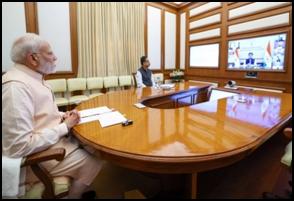
PM GatiShakti National Master Plan

The PM GatiShakti National Master Plan, launched on October 13, 2021, is a comprehensive initiative to improve multimodal infrastructure connectivity across India’s economic zones. Rs. 100 lakh crores are being efficiently utilized through this integrated platform. Anchored on seven key sectors—railways, roads, ports, waterways, airports, mass transport, and logistics infrastructure—it promotes synchronized development across ministries and state governments. The plan uses a dynamic GIS platform developed by BISAG-N (Bhaskaracharya Institute for Space Applications and Geoinformatics) for real-time project mapping and integration of over 200 data layers. This project has onboarded 44 Central Ministries and 36 States/UTs and a total of 1,614 data layers have also been integrated, by October 2024. A milestone of assessing 208 big-ticket infrastructure projects worth Rs. 15.39 lakh crores, of various Ministries adhering to PM Gati Shakti principles has been achieved.
PM GatiShakti will help in achieving the objective of an ‘Aatmanirbhar Bharat’ by providing visibility to various stakeholders. Instead of planning & designing separately in silos, the projects will be designed and executed with a common vision. It will incorporate the infrastructure schemes of various Ministries and State Governments like Bharatmala, Sagarmala, inland waterways, dry/land ports, UDAN. Economic Zones like textile clusters, pharmaceutical clusters, defence corridors, electronic parks, industrial corridors, fishing clusters, agri zones etc. will be covered to improve connectivity & make Indian businesses more competitive. This will boost economic growth, attract foreign investments and enhance the country’s global competitiveness.
National Logistics Policy
The National Logistics Policy (NLP) was launched on 17th September 2022 to boost India’s economic growth by creating an integrated, efficient, and cost-effective logistics network. The policy aims to reduce logistics costs, improve India's Logistics Performance Index (LPI) ranking to be among the top 25 countries by 2030, and promote data-driven decision-making. The policy aims to lower the cost of logistics from the existing 13-14% and lead it to par with other developed countries. This will increase the competitiveness of Indian products in both the Indian home market and the international market. Moreover, the reduced cost will also increase efficiency efforts cutting across all sectors of the economy, which encourages value addition and enterprise.
India’s ranking in World Bank’s Logistics Performance Index (LPI) has improved by sixteen places from 54 (out of 160 countries) in 2014 to 38 (out of 139 countries) in 2023. The World Bank has acknowledged India’s efforts in LPI 2023 report, including investment in soft and hard infrastructure to connect ports on both coasts to economic poles in the hinterland, and supply chain digitization.
Roads and Highways
Expansion of National Highway Network
- As of March 31, 2025, India has more than 63 lakh km of road network, out of which National Highways is 1,46,204 km, State Highways is 1,79,535 km and 60,19,723 km other roads.
- The length of National Highways was 91,287 km in 2013-14. Therefore, there has been an increase of about 60% (to 1,46,204 km) in the length of National Highways. Indian Road Network is the second largest in the world.
- In the last 11 years (2014-25), India has amplified 54,917 kms to the National highways network.
- Length of National High-Speed Corridors (HSC) has expanded from 93 km in 2014 to 2,474 km at present. 3,600 km of high-speed corridors built in last five years.
- Length of 4 lane and above NHs (excluding HSCs) increased by 2.5 times from 18,278 km in 2014 to 45,947 km at present.
- In 2013-14, the pace of NH construction was about 11.6 km/day which increased to about 34 km/day in 2025. The increase in work awards and construction for NH is 108% and 150% respectively between 2013-14 and 2024-25.
- There is an increase of 6.4 times in Ministry investment on road infrastructure between 2013-14 and 2024-25.
- There has been a 570% increase in road transport and highway budget from 2014 to 2023–24.
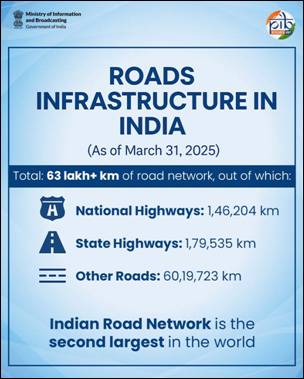
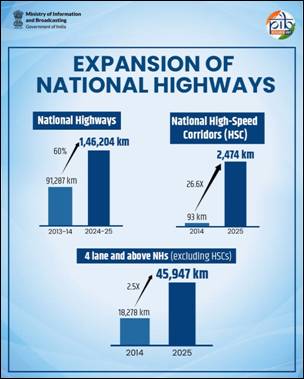
Bharatmala Pariyojana
Bharatmala Pariyojana was approved by Government of India covering a length of 34,800 km with an estimated cost of Rs. 5.35 lakh crore to improve connectivity and reduce logistics cost in the country through construction of Economic Corridor, Inter Corridor, Feeder route, National Corridor efficiency improvement, Border & International Connectivity, Coastal & Port Connectivity Roads and Expressways along with residual National Highways Development Project (NHDP). Projects covering a total length of 26,425 km have been awarded under Bharatmala Pariyojana. Till March 2025, 20,378 km has been constructed as part of Bharatmala Pariyojana.
Major Completed Projects
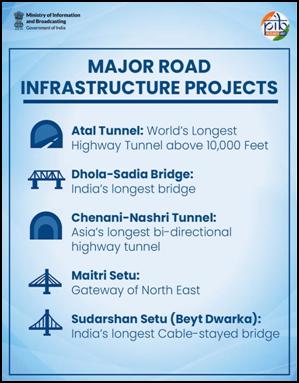
- Atal Tunnel: World’s Longest Highway Tunnel above 10,000 Feet, Atal Tunnel was inaugurated by Prime Minister Shri Narendra Modi on October 3, 2020. The tunnel reduces the road distance by 46 Kms between Manali and Leh and the time by about 4 to 5 hours.
- Eastern and Western Peripheral Expressway: The two projects of Peripheral Expressways around Delhi, comprising 135 km Eastern Peripheral Expressway (EPE) was inaugurated by Prime Minister Shri Narendra Modi on May 27, 2018. The EPE was constructed by NHAI. Further, Kundli-Manesar Section of the Kundli-Manesar-Palwal (KMP) Western Peripheral Expressway inaugurated on November 19, 2018.
- Bogibeel Bridge: The Prime Minister Shri Narendra Modi inaugurated the Bogibeel bridge in Assam on December 25, 2018. The bridge, which spans the River Brahmaputra between Dibrugarh and Dhemaji districts of Assam, is of immense economic and strategic significance for the nation.
- Dhola-Sadia Bridge: In May 2017, Dhola-Sadiya Bridge in Assam was inaugurated by Prime Minister to connect far-off areas and pave the way for their socio-economic development. It is India’s longest bridge, with a length of 9.15 km.
- Chenani-Nashri tunnel: The tunnel in Jammu and Kashmir was opened in 2017. The 9 km long, all-weather tunnel between Udhampur and Ramban in Jammu & Kashmir is not only India’s longest highway tunnel under operation but also Asia’s longest bi-directional highway tunnel, which is equipped with Integrated Tunnel Control System (ITCS).
- Dibang-Lohit River Bridge: The project provides the only link between Bomjur and Meka and Digaru to Chowkham on NH-52. The project established all weather and 24x7 direct connectivity between Pasighat-Roing and Namsai-Tezu, thereby reducing dependence on ferry crossing and providing socio-economic benefits to the region. The distance between Roing and Pasighat and between Tezu and Namsai has been reduced from 310 km to 75 km and from 195 km to 57 km respectively.
- Kollam Bypass: Prime Minister Shri Narendra Modi dedicated to the nation the 13 km, 2 lane Kollam bypass on NH-66 in Kerala on January 15, 2019. Constructed at a cost of Rs 352 crore, this highway has three major bridges over Ashtamudi Lake.
- Maitri Setu: Prime Minister Shri Narendra Modi inaugurated ‘Maitri Setu’ between India and Bangladesh through video conferencing on March 9, 2021. Also called the ‘Gateway of North East’, the crucial bridge built over the Feni River to link with Tripura with Chittagong in Bangladesh is 1.9 km long, built at a cost of Rs. 133 crore.
- Sudarshan Setu (Beyt Dwarka): Hon’ble Prime Minister inaugurated Sudarshan Setu on February 25, 2024 which connects Okha mainland and Beyt Dwarka island, built at a cost of around Rs. 980 crores. It is the longest Cable-stayed bridge in the country of around 2.32 km.
- Sonamarg Tunnel (Z-Morh): Sonamarg Tunnel of length 6.4 km on NH-01 in the UT of Jammu &Kashmir was inaugurated by Prime Minister on January 13, 2025. Situated at an altitude of over 8,650 ft. above sea level, it will enhance all-weather connectivity between Srinagar and Sonamarg enroute to Leh.
Major Projects under implementation
1. Frontier Highway in Arunachal Pradesh: Frontier Highway (NH-913) is a road of strategic importance along Indo-Tibet Myanmar border with intent to arrest the population migration from border areas. The total design length of Frontier Highway is 1,824 km out of which work on 271 km has been taken up by MoD/MoRTH before declaration as National Highway. Balance length of 1,553 km is being sanctioned/awarded by MoRTH in 44 packages to be executed by three agencies viz. State PWD, Border Road Organisation (BRO) and National Highways and Infrastructure Development Corporation Limited (NHIDCL).
2. Delhi-Mumbai Expressway
The ministry has taken up construction of Delhi-Mumbai Expressway including spurs in 53 numbers of packages having 1386 km length. As of June 2024, total 26 numbers of packages have been completed. The physical progress of the work is 82% and cumulative length of 1136 km has been constructed. The revised scheduled completion date is October 2025. The corridor provides connectivity to major economic centers within Delhi, Uttar Pradesh, Haryana, Rajasthan, Madhya Pradesh, Gujarat and Maharashtra. The impact includes reduction in distance from Delhi to JNPT by about 180 km and reduction in travel time of upto 50% to connected destinations.
3. Char-dham Mahamarg Vikas Pariyojana: The Ministry has taken up the connectivity Improvement Program for Char-Dham (Kedarnath, Badrinath, Yamunotri & Gangotri) in Uttarakhand. The programme includes projects of improvement/development of 825 km length of NHs at total estimated cost of about Rs 12,595 crore. So far, 629 km has been completed and the percentage progress is 76% w.r.t total length (825 Km).
4. Other Projects Under Implementation
|
Corridor Name
|
Length
(in km)
|
Total Capital Cost
(in crore)
|
Target Year of Completion
|
|
Ahmedabad - Dholera
|
109
|
4,372
|
FY 24-25
|
|
Bengaluru - Chennai
|
262
|
17,356
|
FY 24-25
|
|
Delhi - Amritsar - Katra
|
669
|
38,905
|
FY 25 -26
|
|
Kanpur – Lucknow Expressway
|
63
|
4,219
|
FY 25-26
|
Progress under PM GatiShakti
The Network Planning Group (NPG) was established by DPIIT, under the chairpersonship of Special Secretary, Logistics (DPIIT), where all central/state infrastructure ministries can coordinate and provide inputs on infrastructure projects presented in the meetings. 131 projects of the MoRT&H have been presented for consultation till April 15, 2025. In addition to these projects, multiple Ministries/ Departments like MoD, MoPSW, NICDC, M/o Steel, D/o Fertilizer etc., have also sent requests for taking up projects to alleviate Critical Infrastructure Gaps out of which 100 projects have been identified as Critical Infrastructure Gap Projects (of which 65 projects pertain to MoRT&H). Details of these 65 Critical Infrastructure Gap Projects are:
|
Status
|
No.
|
Length
(in km)
|
Tentative Cost
(in Rs. Cr.)
|
|
Completed
|
4
|
459.50
|
10,247.63
|
|
Under Implementation
|
5
|
156.81
|
5,148.27
|
|
To be approved in FY25-26
|
12
|
462.00
|
10,511.70
|
|
Non-NH Projects
|
44
|
850.00
|
23,224.00
|
|
No. of Projects taken up by State Government/Port Authorities/Other Agencies
|
16
|
202.00
|
6,602.00
|
|
Non-NH Projects (to be planned based on prioritization by MoPSW)
|
28
|
648.00
|
16,622.00
|
The MoRT&H has uploaded the entire NH network (~1.46 Lakh kms) on GIS platform and validated the same on the NMP Portal. MoRT&H has achieved multifold benefits from the adoption of PM Gati Shakti National Master Plan for the planning and development of National Highway corridors such as:
- Minimized ecological impact through interference with Forest, Wildlife & CRZ
- Optimized alignment with lesser and expedited clearance requirements
- Identification of intersections with other infrastructure and clearances required
- MoRT&H is already incorporating all principles of PM Gati Shakti in all its projects pertaining to National Highways and associated infrastructure.
- MoRT&H has made it mandatory to use the NMP portal for all project planning and preparation activities.
National Electronic Toll Collection (NETC)

In order to ensure seamless movement of traffic through fee plazas and increase transparency in collection of user fee using FASTag, the National Electronic Toll Collection (NETC) programme has been implemented on pan-India basis. As on December 31, 2024, collectively banks have issued over 10.30 crore FASTags; the average daily collection through ETC is around Rs. 192 crore with penetration of about 98.5% in total fee collection. There are 1,051 National Highways fee plazas live with ETC infrastructure in all lanes. The constant growth and adoption of FASTag by highway users is very encouraging and has helped increase efficiency in toll operations.
Recent Cabinet Decisions
On April 30, 2025, the Cabinet Committee on Economic Affairs approved the development, maintenance, and management of a 166.80 km 4-lane Greenfield access-controlled National Highway (NH-06) from Mawlyngkhung (near Shillong, Meghalaya) to Panchgram (near Silchar, Assam) at a total capital cost of Rs. 22,864 crore.
The Cabinet, on April 9, 2025, approved the construction of a 6-lane Zirakpur Bypass, spanning 19.2 km from NH-7 (Zirakpur-Patiala) to NH-5 (Zirakpur-Parwanoo), at a cost of Rs. 1,878.31 crore.
The Cabinet, on March 28, 2025, approved the construction of a 120.10 km long 4-lane greenfield and brownfield corridor between Patna, Arrah, and Sasaram in Bihar at a total cost of Rs. 3,712.40 crore.
The Cabinet, on March 19, 2025, approved the construction of a 29.219 km 6-lane access-controlled greenfield high-speed national highway from JNPA Port (Pagote) to Chowk in Maharashtra at a cost of Rs. 4,500.62 crore.
The Cabinet, on March 5, 2025, approved a 12.4 km ropeway project from Govindghat to Hemkund Sahib Ji in Uttarakhand, to be developed at a cost of Rs. 2,730.13 crore.
The Cabinet, on March 5, 2025, approved the construction of a 12.9 km ropeway from Sonprayag to Kedarnath in Uttarakhand, to be developed at a cost of Rs. 4,081.28 crore.
Rural Roads
Under the Pradhan Mantri Gram Sadak Yojana (PMGSY), a key objective has been to ensure connectivity to all unconnected habitations with a population of 500+ persons in plain areas and 250+ in special category areas (NER & Hill States/ UTs, the Desert Areas, the Tribal areas and selected Tribal and Backward areas as per Census 2001). The entire target of 1,63,000 habitations has been met which has enabled service delivery to these habitations, improved the rural road core network and led to socio-economic transformation in these areas.
PMGSY-II was launched for upgradation of selected Through Routes and Major Rural Links (MRLs) and provide improved connectivity to growth centres. A total of 49,053 km length, out of a target of 50,000 km has been upgraded achieving the objectives of the programme. PMGSY-III was launched in July 2019 for consolidation of 1,25,000 km from the targeted habitations Through Routes and Major Rural Links connecting habitations. A total of 6,96,620 facilities including 1,46,784 schools, 1,38,637 agricultural markets, 82,806 medical centres and 3,28,393 transport facilities have been provided improved connectivity so far under the scheme.
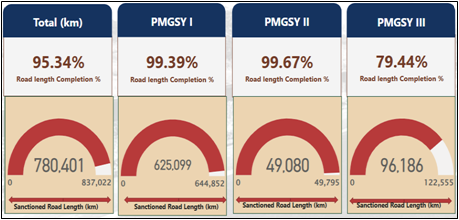
Government has approved Pradhan Mantri Gram Sadak Yojana - IV (PMGSY-IV) on September 11, 2024 to provide all-weather connectivity to eligible unconnected habitations of designated population size. Under PMGSY-IV, 25,000 unconnected eligible habitations are targeted for providing connectivity by constructing 62,500 km all-weather roads. The scheme will be implemented from financial year 2024-25 to 2028-29 with a total outlay of Rs. 70,125 crore. A total of 8,37,022 km road length has been sanctioned under various ongoing interventions/verticals of PMGSY, out of which 7,80,401 km road length has already been completed and upgraded as of May 24, 2025. Rural road connectivity is currently at 99% coverage.
As of March 2025, a total expenditure of Rs. 4,056 crores have been incurred on the maintenance of rural roads constructed under the PMGSY scheme through the eMARG. With aim to make considerable energy and resource saving, various new/green technologies such as Waste Plastic, Cold Mix, Full Depth Reclamation (FDR), Nano Technology, Geotextile etc., are being used in rural road construction. In year 2024, road length of 15,783 km has been constructed under various new/green technologies.
Also, Pradhan Mantri Janjati Adivasi Nyaya Maha Abhiyan (PM-JANMAN) a separate vertical under PMGSY has been launched for providing road connectivity to Particularly Vulnerable Tribal Groups (PVTG) habitations with population sizes up to 100. The target length is 8,000 km with a period of 5 years (2023-24 to 2027-28). So far, 5,718.229 km has been sanctioned under PM-JANMAN for Rs. 4,366.03 crore.
Metro Rail
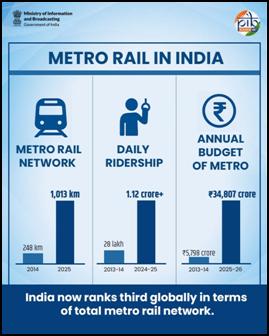
Metro rail is now either running or being built in 23 cities. By May 2025, India had 1,013 km of metro lines in operation, up from just 248 km in 2014. That is an addition of 763 km in just eleven years. India now ranks third globally in terms of total metro rail network. In this period, 34 metro projects spanning 992 km were approved. Daily ridership, which stood at 28 lakh in 2013-14, has now crossed 1.12 crore. The pace of commissioning new lines has grown nine times. On average, 6 km of metro lines are now operationalised every month, compared to just 0.68 km per month before 2014. The annual budget for metro rail has also increased more than six times, rising from ₹5,798 crore in 2013-14 to ₹34,807 crore in 2025-26.
In addition to metro networks, India has also made significant strides with the introduction of the Regional Rapid Transit System (RRTS). The Namo Bharat trains operating on the Delhi-Meerut RRTS corridor are a prime example of India's commitment to modernising mass transit systems, offering faster and more efficient travel across regions.
Railways
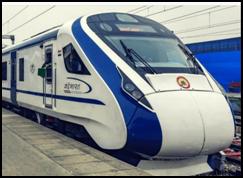
Indian Railways budget has increased by more than 9 times since 2014. Indian railways have introduced World class trains such as:
- Vande Bharat Trains: A Semi high speed train which offers comfortable ride with top notch amenities, covering 24 States/UTs along with 333 districts. A total 68 Vande Bharat Trains (136 Services) are currently operational in the country. 400 world-class Vande Bharat Trains are planned to be manufactured.
- Amrit Bharat Train: It is a non-AC, push-pull train which provides a jerk free journey with enhanced safety and improved amenities, designed and developed by Indian Railways at ICF Chennai. Total 3 Amrit Bharat Trains (6 Services) are in currently in operation.
- Namo Bharat Rapid Rail: It is a short distance service that operates on an inter-city Network, designed and developed by Indian Railways at RCF Kapurthala. Total 2 Namo Bharat Rapid rail (4 Services) are running currently.
200 new Vande Bharat trains, 100 Amrit Bharat trains, 50 Namo Bharat rapid rail & 17,500 general non-AC coaches are planned to revolutionize travel experience for masses in next 2 to 3 years.
Track Upgradation
- More than 31,000 km of new tracks have been laid since 2014.
- More than 45,000 km of tracks have been renewed since 2014.
Total Capex Allocation
- 2004 - 2014: With around 3.62 lakh crore.
- Since 2014: More than 17 lakh crore.
Amenities
- 1,790 lifts and 1,602 escalators have been installed at railway stations with the aim of improving accessibility for all passengers and ensuring inclusivity at railway stations.
- Over 6,000 railway stations are equipped with WIFI facility ensuring greater connectivity.
Mission Net Zero Carbon emission 2030
- Indian Railways is advancing to achieve the target of Indian Railways’ electrification and presently, over 98% of the broad-gauge network has been electrified.
- Over 2,000 railway stations are solar powered ensuring progress in achieving an energy efficient rail network.
- 100 % LED lights have been installed at railway stations, service buildings etc.
Enhanced Production
- Indian Railways is replacing its fleet with more safe and secure LHB coaches. Since 2014 Indian Railways manufactured more than 37,000 such coaches to provide improved safety and comfort.
- 7,134 coaches produced in 2024-25, marking an increase of 9% from the previous year’s production of 6,541 coaches.
- 41,929 units of wagons produced in 2024-25, surpassing the 37,650 units in 2023-24.
- 1,681 units of locomotives produced in 2024-25, marking a 19% increase with 1,472 units in 23-24 (more than Europe, North America, South America, Africa and Australia combined).
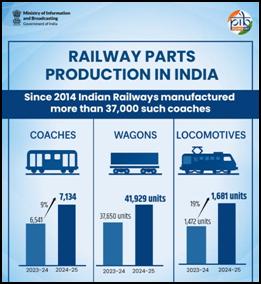
Kavach - Automatic Train Protection System
- Kavach is an indigenously developed Automatic Train Protection (ATP) system. Kavach is a high technology intensive system, which requires safety certification of highest order (SIL- 4).
- Kavach aids the Loco Pilot in running of trains within specified speed limits by automatic application of brakes in case Loco Pilot fails to do so and also helps the trains to run safely during inclement weather.
- Kavach has already been deployed on 1,548 Route km on South Central Railway and North Central Railway. Presently, the work is in progress on Delhi - Mumbai & Delhi - Howrah corridors (approx. 3,000 Route km). Track side works at about 1,081 Rkm (705 Rkm on Delhi - Mumbai section and 376 Rkm on Delhi-Howrah section) on these routes have been completed.
Elimination of unmanned level crossing (ULC)
- With 100% elimination of ULC, Indian Railways have constructed more than 12,000 Road Over Bridges and Road Under Bridges ensuring safe passage for both road and rail users.
- 1,256 new ROBs/RUBs were constructed in 2024-25.
Recent Infrastructure Developments
- Chenab Bridge - World's Highest Railway Arch Bridge and Anji Khad Bridge - India's first Cable stayed Rail Bridge were inaugurated by PM in June 2025. The Anji Bridge will serve the nation in a challenging terrain. Chenab Rail Bridge is situated at a height of 359 meters above the river. It is a 1,315-metre-long steel arch bridge engineered to withstand seismic and wind conditions.
- The New Pamban Bridge (India’s first Vertical Lift Rail Sea Bridge), revolutionising rail connectivity for Rameswaram and Mainland India has been dedicated to the nation.
- Kosi Rail Mahasetu: Inaugurated by Prime Minister Shri Narendra Modi on September 18, 2020. This bridge is of strategic importance along the India-Nepal border.
Progress of Ongoing Schemes/Programmes
- Pace of Electrification: 5,188 Rkm of broad-gauge rail network was electrified between 2004-14 whereas more than 45,000 Rkm was electrified in 2014-25. Electrification has enabled annual savings of Rs. 2960 crore for railways (up to February 2025), ensuring greater financial efficiency.
- Electrical/Electronic Interlocking Systems: To eliminate accidents due to human failure, centralized operation of points and signals have been provided at more than 6,600 stations as of March 31, 2025.
- One Station One Product Scheme (OSOP): A scheme of the Ministry of Railways that aims to provide enhanced opportunities to local artisans, potters, weavers, craftsmen etc., through provisions of sale outlets at Railway Stations across the country. A total of 2266 OSOP outlets are operational at 1,979 stations making a total sale of Rs. 107.89 Cr, as of March 31, 2025.
- Freight Loading: Indian Railways exhibits a remarkable growth in terms of freight loading since 2014. While it was 8,473 MT in 2004-2014, in 2014-25, the figure stood at more than 14,200 MT. An all-time high was recorded in 2024-25 with 1,617.38 MT.
- Dedicated Freight Corridor (DFC): Before 2014 not a single kilometer of DFC was commissioned. Post 2014, more than 96% of DFC (2843 km) has been completed with Eastern DFC (1337 KM) has been completed and Western DFC (1506 KM) is about to complete.
Recent Initiatives and their progress
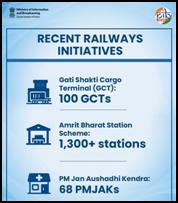
- Gati Shakti Cargo Terminal (GCT): 100 GCTs have been commissioned for reducing logistic cost and improving multi modal transport.
- Amrit Bharat Station Scheme: More than 1300 stations are being redeveloped under the scheme ensuring introduction of world class facilities.
- PM Jan Aushadhi Kendra - 68 PMJAKs are operating at various Railway Stations ensuring accessibility and availability of affordable medicinal facilities at station premises.
Recent Cabinet Decisions
On April 9, 2025, the Cabinet approved the doubling of the 104 km Tirupati–Pakala–Katpadi railway line at an estimated cost of Rs. 1,332 crore.
On April 4, 2025, the Cabinet approved four major railway projects worth approximately Rs. 18,658 crore, covering 15 districts across Maharashtra, Odisha, and Chhattisgarh.
On February 7, 2025, the Cabinet approved the reorganisation of the Waltair railway division. Around 410 km, including routes like Palasa–Visakhapatnam–Duvvada, will stay under South Coast Railway as the new Visakhapatnam division. The remaining 680 km, covering routes like Kottavalasa–Bacheli, will become a new division under East Coast Railway with headquarters at Rayagada.
Civil Aviation
There are 160 operational airports in the country, which include 145 airports, 02 Water aerodromes and 13 Heliports as of March 2025.
Major Projects Completed
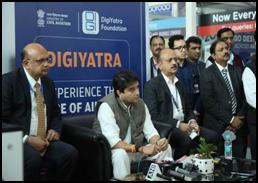
Greenfield Airports Operationalised
The Ministry has emphasized regional development and economic inclusion through the establishment of multiple greenfield airports:
- Durgapur Airport, West Bengal (2015): This airport was instrumental in improving connectivity to the eastern industrial belt.
- Shirdi Airport, Maharashtra (2017): Positioned to serve religious tourism, this airport saw heavy traffic growth soon after commencement.
- Kannur Airport, Kerala and Pakyong Airport, Sikkim (2018): These provided vital links to two states with unique geographic and economic challenges.
- Kalaburagi Airport, Karnataka (2019): Created to promote regional economic integration.
- Kurnool Airport, Andhra Pradesh (2020): Enhanced accessibility to a fast-developing region in southern India.
- Kushinagar and Sindhudurg Airports (2021): Played key roles in boosting tourism and regional trade.
- Donyi Polo Airport, Itanagar (2022): A strategic airport in Arunachal Pradesh enhancing border connectivity.
- MoPA Airport, Goa (2023): Complemented existing airport infrastructure and supported Goa’s growing tourism industry.
These airports contributed to decentralizing aviation growth, increasing regional tourism, creating employment, and easing pressure on metro airports.
Digital and Security Infrastructure Enhancements
- eGCA Project: This was a landmark project launched in May 2019 and completed by July 2021 to digitize the Directorate General of Civil Aviation’s operations. 298 services moved online, drastically improving regulatory compliance, transparency, and ease of doing business.
- Biometric Access Control (AEP): A national biometric-based system for airport staff entry, introduced in December 2019, was a major leap towards advanced aviation security. It reduced human error, enhanced threat detection, and eliminated impersonation.
- Digi Yatra: Implemented from 2022 onwards, Digi Yatra enabled paperless, contactless processing of passengers using facial recognition technology. By March 2025, more than 5.22 crore passengers had used this facility. Digi Yatra App is available on android as well as iOS platform and has been downloaded by over 01.21 crore users so far. It was rolled out across 24 major airports.
- e-BCAS: Introduced to streamline the Bureau of Civil Aviation Security’s internal and external processes. This initiative, launched in December 2019, created a paperless ecosystem to monitor compliance, issue licenses, and conduct security audits. e-BCAS (Software) is the part of Digital India, which is developed by NIC.
Major Schemes and Initiatives
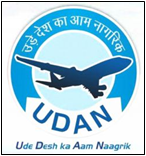
1. Regional Connectivity Scheme (RCS) UDAN (Ude Desh Ka Aam Nagrik)
This flagship scheme under the National Civil Aviation Policy (NCAP), released in June 2016 to create affordable, yet economically viable and profitable air travel on regional routes. New routes and new airports have been added to the civil aviation landscape of the country. The number of airports operational in India have gone from 74 in 2014 to 160 in 2025. Cabinet Committee on Economic Affairs (CCEA) has approved the revival and development of unserved and under-served airports at the total cost of Rs. 4500 crores. In addition to the above, Expenditure Finance Committee (EFC) also approved an amount of Rs. 1000 crores for the development of 50 more airports, heliports and water aerodromes under the UDAN scheme. Further:
- 625 routes have been operationalized;
- 88 unserved and underserved airports have been activated (including 13 heliports and 2 water aerodromes);
- Over 1.51 crore passengers have flown on RCS flights;
- 3.05 lakh flights have been operated; and
- Rs. 4,029 crore viability gap funding has been disbursed.
The scheme ensures equitable regional connectivity, with heavy focus on North East India, hilly terrain, and tribal belts. For the North East region, 90 RCS routes and 12 airports/Heliports/Water Aerodromes have been operationalised.
2. Krishi UDAN
Launched in September 2020, Krishi UDAN enables faster transport of agricultural produce and perishables, especially to benefit the tribal and northeastern states. In convergence with the Operation Greens Scheme, it offers 50% freight subsidy, multimodal transport options, and coverage of horticulture and allied produce.
3. Lifeline UDAN
This special initiative was launched in March 2020, during the COVID-19 lockdown to ensure uninterrupted medical and essential supply deliveries. Over 588 flights carried 1,000 tons of cargo across 5.45 lakh km, focusing particularly on the North Eastern region, Islands, and hilly terrains. Lifeline UDAN also supported setting up COVID labs, transporting medical teams, and responding to emergencies like the Vishakhapatnam gas leak.
4. Helicopter Emergency Medical Services (HEMS)
Launched in October 2024 as a joint venture between MoCA, the Ministry of Health and Family Welfare and the Uttarakhand Government. It is the country’s first air ambulance model providing trauma care in hilly terrains. The pilot project at AIIMS Rishikesh has already proven successful.
5. Drone Ecosystem Reforms
From Drone Rules, 2021 (to further liberalize the emerging drone industry) to the launch of Digital Sky, 2018 (an online portal for drone registration) has enabled exponential growth in drone-based services. The Production Linked Incentive (PLI) scheme of amount Rs 34.79 crores which were disbursed during FY 24-25 and import bans on foreign drones have spurred indigenous manufacturing. Bharat Drone Mahotsav (2022) and the upcoming Drone Bill (2025) are shaping India’s global drone footprint. The Civil Drone (Promotion and Regulation), Bill, 2025 is formulated with keeping in view, the unique requirements of the emerging drone sector. Growing Drone Ecosystem can be understood with the following figures:
- Number of registered drones - 32,108
- Number of Remote Pilot Certificates - 26,081
- Number of Type Certificates - 106
- Number of Remote Pilot Training Organization - 172
Policy and Legislative Framework
- Anti-Hijacking Act, 2016: This Act provides for broadening of definition of hijacking and extension of jurisdiction. The Act further provides for confiscation of movable and immovable property besides punishment of life imprisonment (for the remainder of person’s natural life) and with fine.
- Aircraft (Security) Rules, 2023 & Amendments (2024): Empower authorities to act proactively against threats in the interest of national and civil security.
- Bharatiya Vayuyan Adhiniyam, 2024: It is a legislative reform aimed at modernizing India’s aviation sector by re-enacting the Aircraft Act, 1934, in alignment with contemporary needs and global standards. The new legislation will foster indigenous manufacturing under Make in India and Atmanirbhar Bharat initiatives, align with international conventions like the Chicago Convention and ICAO, and streamline regulatory processes, such as simplifying the issuance of licenses. The Act removes redundancies and provides provisions for appeals.
- Protection of Interests in Aircraft Objects Act, 2025: Enables better asset protection for lessors, crucial for expanding aircraft leasing.
Social Inclusion and Passenger Experience
- Women in Aviation: India leads globally with 15% women pilots. MoCA issued guidelines in 2024 to target 25% women workforce by 2025. 15% of the country's air traffic controllers are women and 11% of flight dispatchers are women. Further, 33% of Flight Operator Inspectors (FOIs) in DGCA are women.
- UDAN Yatri Cafés: In order to offer affordable meal options to the passengers at the airports, the first UDAN Yatri Cafe was launched on December 19, 2024, at Netaji Subhas Chandra Bose International Airport in Kolkata. Subsequently, such cafes were introduced at Chennai and Ahmedabad Airports.
- Baggage Reforms: Turnaround time for last baggage reduced to under 30 minutes at major airports. During January 2024 to June 2024, baggage received within 30 minutes has improved from 62% to 97%.
Recent Cabinet Decisions
On June 19, 2024, the Cabinet approved a proposal by the Airports Authority of India (AAI) for upgrading the Lal Bahadur Shastri International Airport in Varanasi at the estimated cost of Rs. 2,869.65 crore.
Approved by the Cabinet on August 16, 2024, this project involves the construction of a new civil enclave at Bihta, Patna, with an investment of Rs. 1,413 crore.
Also approved by the Cabinet on August 16, 2024, a Rs. 1,549 crore project will develop a new civil enclave at Bagdogra Airport, Siliguri.
Apart from this, Canal National Project was also inaugurated by the Prime Minister Shri Narendra Modi in Balrampur, Uttar Pradesh on December 11, 2021.
Ports, Shipping and Waterways
Major Projects Completed
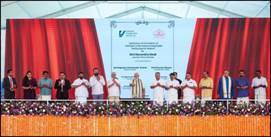
- Vizhinjam International Deepwater Multipurpose Seaport: Inaugurated on May 2, 2025, by Prime Minister Narendra Modi, this Rs. 8,800 crore project is India’s first dedicated container transshipment port. Strategically located near international shipping routes, it can host the world’s largest cargo ships. The port significantly reduces India's reliance on foreign ports and enhances economic activity in Kerala.
- New Dry Dock (NDD) at Cochin Shipyard Limited: Constructed at a cost of Rs. 1,800 crores, with a length of 310 meters and depth of 13 meters, it is capable of handling aircraft carriers of up to 70,000 tons displacement.
- International Ship Repair Facility (ISRF), Cochin: Asia’s largest ship repair facility built at Rs. 970 crores. Can accommodate seven vessels of 130 meters simultaneously with a lifting capacity of 6000 tons.
- Jal Marg Vikas Project (JMVP): Approved at Rs. 5,370 crores to augment capacity of National Waterway-1 (Haldia to Varanasi), this major inland navigation initiative enhances cargo movement on the Ganga River.
Major Projects in Progress
- Vadhvan Deep Draft Port: Envisioned as one of the world’s top 10 container ports. Being developed with an investment of Rs. 76,000 crore and capacity of 23 million TEUs under PPP mode.
- Container Terminal at Tuna Tekra, Deendayal Port: Awarded under Public-Private Partnership (PPP) with an estimated cost of Rs. 4,200 crores. It features an annual handling capacity of 2.19 million Twenty-foot Equivalent Units (TEUs), positioned to cater to trade demands from northern, north-western, and central India.
- Western Dock Project, Paradip Port: A Rs. 3,000 crore PPP project with a capacity of 25 MMTPA, supporting cape-size vessels with a draft of 18 meters.
- Green Hydrogen Hubs: Under development at three major ports - Deendayal (Kandla), VOC Port (Tuticorin), and Paradip Port. These align with India’s National Green Hydrogen Mission to enable generation, storage, and export of green hydrogen.
- Construction of India’s Largest Hopper Dredger: With 12,000 m³ capacity, being constructed by Cochin Shipyard Limited for the Dredging Corporation of India.
Major Schemes and Programs
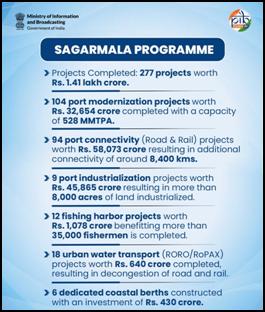
1. Sagarmala Programme
The Sagarmala Programme, launched in March 2015, is a flagship initiative aimed at revolutionizing India’s maritime sector. With a 7,500 km coastline, 14,500 km of potentially navigable waterways, and a strategic position on key global trade routes, India holds immense potential for port-led economic growth. Sagarmala aims to streamline logistics, reduce costs, and enhance international trade competitiveness by shifting from traditional, infrastructure-heavy transport to efficient coastal and waterway networks.
The Sagarmala Programme is a key pillar of the Maritime Amrit Kaal Vision 2047. The Government of India is advancing the Sagarmala Programme with Sagarmala 2.0, focusing on shipbuilding, repair, recycling, and port modernization to enhance India's maritime competitiveness. With a budgetary support of Rs. 40,000 crore, the initiative aims to leverage investments of Rs. 12 lakh crore over the next decade, driving infrastructure development, coastal economic growth, and job creation.
2. Greening the Maritime Sector
- Harit Sagar Guidelines: Promote renewable energy, shore-to-ship power, and circular economy in ports.
- Harit Nauka Guidelines: Encourage e-carbonization of inland vessels through retrofitting and building alternate fuel vessels like electric, hydrogen, ammonia-based.
- Green Tug Transition Programme (GTTP): Transitioning of tugboats at major ports from conventional fuel to zero and near-zero (ZNZ) fuels by 2047.
- India-Singapore Green Shipping Corridor: First-of-its-kind international green and digital corridor.
3. One Nation One Port Process (ONOP)
Introduced to standardize documentation and processes across all major ports. Expected to reduce paperwork by 25% for container and bulk cargo operations, leading to significant logistics cost savings.
Performance Highlights (2014–2025)
1. Ports Sector
- Port capacity: Doubled from 1,400 MMTPA to 2,762 MMTPA
- Cargo handled: Increased from 972 MMT to 1,594 MMT
- Vessel turnaround time: Overall turnaround time reduced from 93 hours to 49 hours
- Net annual surplus: Increased from ₹1,026 crore to ₹9,352 crore
- Operating ratio: Improved from 73% to 43%
2. Shipping Sector
- Indian flagged ships: Increased from 1205 to 1549
- Gross tonnage: Rose from 10 MGT to 13.52 MGT
- Coastal shipping cargo: Increased from 87 MMT to 165 MMT
- Seafarers: Grew from 1.17 lakh to 3.20 lakh; women seafarers up 10 times
- New routes: India-Maldives cargo service; India-Sri Lanka passenger service
3. Inland Waterways
- Operational waterways: Up from 3 to 29
- Cargo handled: Rose from 18 MMT to 146 MMT (710% increase)
- Ferry/Ro-Pax passengers: More than 7.5 crore in 2024-25
4. Tourism
- Sea cruise passengers: Increased from 0.84 lakh to 4.92 lakh (480% growth)
- River cruise routes: Increased from 3 to 13
- Lighthouse tourism: Up from 4.34 lakh to 18.63 lakh (330% growth)
- Ganga Vilas: World’s longest river cruise from Varanasi to Dibrugarh completed in 2023
Apart from this period, National Waterways (NWs) notified increased from 5 in 2013-14 to 111 by 2016.
Recent Cabinet Decisions
The Cabinet on October 3, 2024 approved changes to the PLR (Productivity Linked Reward) Scheme for major port and dock workers for the 2020-21 to 2025-26 period.
The Cabinet on October 9, 2024, approved Phase 1B and Phase 2 of development of National Maritime Heritage Complex (NMHC). Phase 1B includes 8 new galleries and a world’s tallest Light House Museum.
International Cooperation
- Over 21 MoUs signed with global partners (Norway, Denmark, UAE, South Korea, Bangladesh, etc.).
- In 2024, India-Iran signed a 10-year agreement for operating Shahid Beheshti Port at Chabahar, providing India the legal rights to operate the port. It will be a vital nodal point for international north-south transport corridor network.
- Collaboration with Portugal, UAE, Vietnam, and Thailand for National Maritime Heritage Complex.
- MoU with International Association of Marine Aids to Navigation and Lighthouse Authorities (IALA) and DGLL for training in marine navigation aids in 2016.
- India-Middle East-Europe Economic Corridor (IMEC): Launched during India’s G20 presidency, this project enhances maritime connectivity with Europe and the Middle East. Expected to reduce logistics costs by 30% and transit time by 40%.
Conclusion
India’s infrastructure journey from 2014 to 2025 stands as a testament to focused policy-making, technological innovation, and massive public investment. As the nation moves toward Viksit Bharat@2047, continued focus on last-mile connectivity, multimodal integration, and climate resilience in infrastructure will be vital in realizing the full potential of India’s demographic and geographic strengths.
References
Ministry of Road Transport & Highways
Ministry of Rural Development
Ministry of Railways
Ministry of Civil Aviation
Ministry of Ports, Shipping and Waterways
https://archive.pib.gov.in/newsite/PrintRelease.aspx?relid=117685
https://pmgatishakti.gov.in/pmgatishakti/about_pmgati
https://www.pib.gov.in/PressNoteDetails.aspx?NoteId=153274
https://www.investindia.gov.in/team-india-blogs/national-logistics-policy-india
https://sansad.in/getFile/loksabhaquestions/annex/184/AU272_bm8Dsw.pdf?source=pqals
https://www.pib.gov.in/PressReleseDetail.aspx?PRID=2125467
https://www.pib.gov.in/PressReleseDetail.aspx?PRID=2120357
https://www.pib.gov.in/PressReleseDetail.aspx?PRID=2116186
https://www.pib.gov.in/PressReleseDetail.aspx?PRID=2112781
https://www.pib.gov.in/PressReleseDetail.aspx?PRID=2108416
https://www.pib.gov.in/PressReleseDetail.aspx?PRID=2108412
https://app.powerbi.com/view?r=eyJrIjoiMmNlNzVkMDYtYjJmMC00MWYyLTk0M2UtNzA5MmI3ZTQwZjdjIiwidCI6IjliZjc5NjA5LWU0ZTgtNDdhZC1hYTUzLTI0NjQ2MTg1NTM4YyJ9&pageName=ReportSection6b29be769c4ff01a033b
https://www.pib.gov.in/PressReleseDetail.aspx?PRID=2100853
https://www.pib.gov.in/PressReleasePage.aspx?PRID=2061667
https://www.pib.gov.in/PressReleseDetail.aspx?PRID=2120355
https://www.pib.gov.in/PressReleseDetail.aspx?PRID=2118723
https://www.pib.gov.in/PressReleseDetail.aspx?PRID=2067658
https://www.pib.gov.in/PressReleseDetail.aspx?PRID=2026702
https://www.pib.gov.in/PressReleseDetail.aspx?PRID=2046090
https://www.pib.gov.in/PressReleseDetail.aspx?PRID=2046091
https://www.pib.gov.in/PressNoteDetails.aspx?NoteId=154398
https://www.pib.gov.in/PressReleasePage.aspx?PRID=2061670
https://www.pib.gov.in/PressReleseDetail.aspx?PRID=2063453
https://www.pib.gov.in/PressReleasePage.aspx?PRID=2115878
https://x.com/RailMinIndia/status/1499759995294195719
https://www.pib.gov.in/PressReleasePage.aspx?PRID=1880272
https://www.pib.gov.in/PressReleseDetailm.aspx?PRID=2090364
https://www.pib.gov.in/PressNoteDetails.aspx?NoteId=154085
https://www.pib.gov.in/PressReleasePage.aspx?PRID=1553220
https://www.pib.gov.in/PressReleasePage.aspx?PRID=1661260
https://www.pib.gov.in/PressReleaseIframePage.aspx?PRID=1796961
https://www.pib.gov.in/Pressreleaseshare.aspx?PRID=1557286
https://www.pib.gov.in/Pressreleaseshare.aspx?PRID=1559863
https://www.pib.gov.in/PressReleaseIframePage.aspx?PRID=1655178
https://www.pib.gov.in/PressReleasePage.aspx?PRID=1780489
Click here to download PDF
*********
Explainer 11/ Series on 11 Years of Government
Santosh Kumar | Sarla Meena | Rishita Aggarwal
(Backgrounder ID: 154624)
Visitor Counter : 54